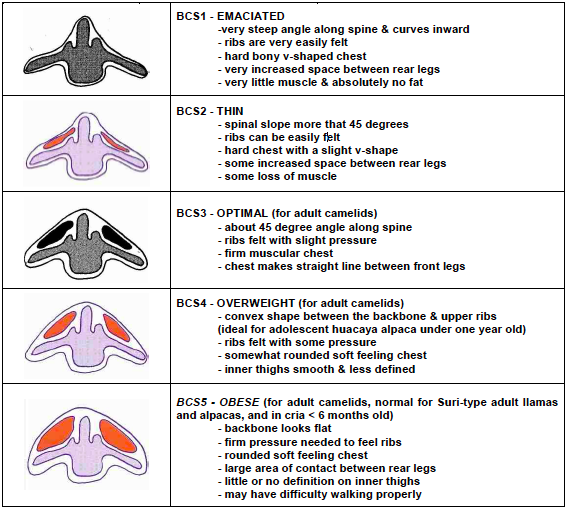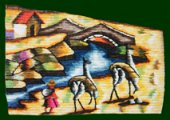THE BASICS
FOLLOW THE 5 FREEDOMS – look it up
|
- They’re a herd animal MUST NEVER BE KEPT ALONE. Must be kept with other alpacas. Minimum herd is 3.
- There must be shelter(s) big enough for the size of the group and a compound off the shelter for access to free grazing. 18FT X 9 shelter is big enough for 5.
- They must have access to clean drinking water and ad lib hay at all times including when in holding/compound area.
- Stocking-density is 3 – 5 an acre plus a resting paddock of same size for quarantine or isolation (with a mate for company). They are frequently overstocked and sold as lawn mowers.
- Llamas are shorn as required but not on an annual basis. Alpacas must be shorn annually (suris every 2 years) and restrained by ropes on the ground or on a shearing table.
- Must use a shearer experienced in shearing alpacas. Seniors (age 10 +) with little fleece can be shorn every 2 years.
- They need fibre in the diet and it needs to be long i.e. Hay
- They need a camelid specific mineral feed daily unless obese. Pregnant and nursing mums, crias, the elderly and sick all require additional attention and supplementary nutrition.
- Must have plenty of feeding stations spaced apart to reduce bullying. Small herds can feed in individual pens.
- Owners must have a handling/holding area with a catch pen for routine tasks and husbandry.
- They are susceptible to clostridial disease and should be vaccinated annually e.g. Lambivac, covexin 8. Routine worming, or fecal testing is required.
- Vit D is a must, usually given as A, D & E during the winter months because they have evolved at very high UV light levels and the U.K. winters not only lack sunshine but have short daylight hours. Start Oct – April
- Alpacas' toe nails need to be trimmed approx every 8 weeks. Llamas toe nails need to be trimmed as required. Also routine top knot trimming to keep fleece out of eyes. Black toe nails grow more slowly, nobody knows why.
- Teeth need checking and trimming, especially in thin animals.
- You cannot judge body weight or condition visually when in full fleece – must body score. A weekly hands on health check is vital. See 14 point health assessment.
- Cria coats in wet cold weather. Also for the elderly or sick or recently shorn adults especially suris due to the fleece parting down their backs and being shorn every 2 years.
- They are obligate nasal breathers and correct halter fit is vital.
- Halter trained does not mean easy to handle. Many halter trained camelids are very difficult to handle and many non haltered trained are easy to handle. It's a selling point giving the false impression halter trained means easy to handle.
- Jaw line needs regular checking for abscesses and loose teeth.
- If Microchipped remove eartags (not compulsory) as they snag and cause infections.
- Study Behaviour and understand it. One of the most important things to learn.
- Mange caused by Mites is a problem. They are highly susceptible to Ulcers, gastro intestinal parasites, TB and BVD , Liverfluke and coccidia etc. Diarrhoea is uncommon and a good indicator of illness.
- Barbed wire and electric wires or tapes are hazardous and unsuitable as fencing. Hay nets can be lethal and must not be used.
- Remove all poisonous plants.
- Show very little signs of illness until the later stages. This includes TB animals, owners who know their animals will notice very subtle signs.
- Must never be transported alone. Max transit time is 2-3 hours. Journeys longer than this will require a break so they can stand to urinate, feed cria, eat, etc. They kush (lie down) while moving.
- Do not castrate before 1 year unless on welfare grounds because it can result in a failure of the growth plates to fuse, leading to a leggy tall animal prone to arthritis.
- Never ever separate mum from cria unless in an emergency.
- Member of the camelid family.
- Originate from the Altiplano of the Andes, Peru, Bolivia and Chile.
- A baby is called a Cria (pronounced cre-a), females Hembras & males Machos. From being weaned to the age of 2 they are called a Tui.
- Weaned at about 6 months but not earlier than 4 months.
- Age 2 they are an adult, age 10 a Senior.
- Dutch uncles and Aunties look after the young ones.
- Social Groups form and each group will have an alpha female or male.
- Maiden mothers can have difficult births and/or mismother.
- They're induced ovulators who breed all year. Mating should be timed so that crias are born between late spring and August at the latest.
- Gestation period for alpacas and llamas is approx 11months plus or minus 20 days. Females first mated from 18 months/2 years of age.
- The spit (C1 ingesta) smells foul.
- They live up to the age of approx. 20 years
- Although they graze and cud they are not a true ruminant as they have no rumen; they are foregut fermenters though: Fermentation chambers are C1, C2, and C3. C3 has an area of “true” stomach
- Alpacas are used for Fleece it is known as Fibre and the finished product when spun is called yarn. Colours range white to black through grey, fawns to browns and multicolours. You are paid nothing for the fleece. It won’t cover the cost of shearing.
- Not all camelids are micro chipped or ear tagged.
- There are no licensed drugs for camelids in the U.K. We use products licensed for other species under veterinary guidance.
- The often used sedative (xylazine/Rompun) for cattle and sheep is ineffective if used alone in camelids. Better results are obtained with the triple cocktail Rompun Torbegesic and Ketamine as detailed in these handouts.
- Need a stress free environment and be handled with respect patience and care.
|
|
Below is a list for you to do a quick health assessment.
|
|
See Body Scoring chart shown below.
|
|
Adult: 99-101.8 deg F or 37.2–38.7 deg C
Cria: 100–102.2 deg F or 37.3–39.0 deg C
Camelids can have a normal temperature but be very ill, and are able to alter their normal temperature up or down to match the environment to some extent, thus a slightly “high” temperature on a hot day is of less concern than on a cold day.
|
|
Between 10-30 per minute but will increase if stressed or being handled by strangers. Once restraint is over, normal respiratory rates should resume within 15 minutes.
|
|
60–90 beats per minute but again will increase when stressed.
|
|
Are toe nails overgrown? See Toe Nail section. Also check between toes for signs of infection if kept on wet ground for a long time.
|
|
Are they so overgrown the incisors completely obscure the dental plate or rub on the lips/gums? Especially important in a thin animal.
|
|
Are they bright, clear & wide open and with no discharge?
|
|
If ear tags are present check around tag for infection.
|
|
Any signs of mites/mange rain scald, abscesses, or fly strike?
|
|
Any difficulty in gait, keeping up with the group?
|
|
Any sign of diarrhoea? Remember diarrhoea is uncommon in camelids and therefore is a cause for concern. Suggest faecal sample.
|
|
Camelids are obligate nasal breathers. They can only breathe through their noses. Any camelid which is mouth breathing is in serious trouble.
|
|
Colour of gums, especially useful in anaemia; in coloured (female) animals look inside the vulval lips because gums are blackish anyway.
|
|
Alert, upright, active, grazing, cudding, not hunched over. If lying, are feet tucked under normally, or out to the side, indicating abdominal or chest pain? Separation from the group is cause for concern.
|



